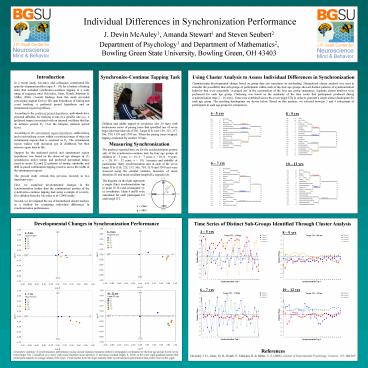Individual Differences in Synchronization Performance - PowerPoint PPT Presentation
1 / 1
Title:
Individual Differences in Synchronization Performance
Description:
In a recent study, McAuley and colleagues constructed life span ... tapping task using a sample of seventy-five children from the McAuley et al. (2006) study. ... – PowerPoint PPT presentation
Number of Views:23
Avg rating:3.0/5.0
Title: Individual Differences in Synchronization Performance
1
Individual Differences in Synchronization
Performance
Introduction
Synchronize-Continue Tapping Task
Using Cluster Analysis to Assess Individual
Differences in Synchronization
In a recent study, McAuley and colleagues
constructed life span development profiles (ages
4 95) for a battery of timing tasks that
included synchronize-continue tapping at a wide
range of sequence rates (McAuley, Jones, Holub,
Johnston Miller, 2006). Overall, findings from
this study provided converging support for two
life span hypotheses of timing and event
tracking a preferred period hypothesis and an
entrainment region hypothesis. According to the
preferred period hypothesis, individuals have
personal affinities for tracking events at a
specific rate (i.e., a preferred tempo)
associated with an internal oscillator that has
an intrinsic period, P0. Over the lifespan,
intrinsic period slows. According to the
entrainment region hypothesis, stable timing and
event tracking occurs within a restricted range
of rates (an entrainment region) that is centered
on P0. The entrainment region widens with
increased age in childhood, but then narrows
again later in life. Support for the preferred
period and entrainment region hypotheses was
based on the observed age changes in (1)
spontaneous motor tempo and preferred perceptual
tempo (used to assess P0) and (2) patterns of
timing variability and drift in paced
continuation tapping (used to assess the width of
the entrainment region). The present study
extends this previous research in two important
ways First, we examined developmental changes
in the synchronization (rather than the
continuation) portion of the synchronize-continue
tapping task using a sample of seventy-five
children from the McAuley et al. (2006) study.
Second, we investigated the use of hierarchical
cluster analysis as a method for examining
individual differences in synchronization
performance.
Characterizing developmental change based on
group data can sometimes be misleading.
Hierarchical cluster analysis was used to
consider the possibility that sub-groups of
participants within each of the four age groups
showed distinct patterns of synchronization
behavior that were essentially averaged out in
the construction of the four age group summaries.
Separate cluster analyses were performed for each
age group. Clustering was based on the similarity
of the time series that participants produced
during synchronization (taps 2 16 only). Data
were combined across the seven target ITIs in
order to generate a single cluster dendogram for
each age group. The resulting dendograms are
shown below. Based on this analysis, we selected
between 3 and 4 sub-groups of participants in
each age group for comparison.
Children and adults tapped in synchrony (for 30
taps) with isochronous series of pacing tones
that specified one of seven target
inter-tap-intervals (ITIs). Target ITIs were 150,
225, 337, 506, 759, 1139 and 1709 ms. When the
pacing tones stopped, tapping continued for
another 30 taps.
Measuring Synchronization
The analyses reported here are for the
synchronization portion only of the
synchronize-continue task for four age groups of
children (4 5 years, n 16 6 7 years, n
20 8 9 years, n 20 10 12 years, n 19).
Accuracy and stability of participants thirty
synchronization taps at each of the seven target
ITIs (150, 225, 337, 506, 759, 1139 and 1709 ms)
were assessed using the circular statistics
measures of mean direction (?) and mean resultant
length (R), respectively.
The diagram on the right represents a single
(late) synchronization tap in polar (?, R) and
rectangular (x, y) coordinates. Mean ? and R were
calculated for each participant for each target
ITI.
Developmental Changes in Synchronization
Performance
Time Series of Distinct Sub-Groups Identified
Through Cluster Analysis
?
?
?
?
ReferencesMcAuley, J. D., Jones, M. R., Holub,
S., Johnston, H. Miller, N. S. (2006). Journal
of Experimental Psychology General, 135,
348-367.
Descriptive summary of synchronization
performance (using circular statistics measures
plotted in rectangular coordinates) for the four
age groups for the seven tested target ITIs.
Considered as a vector, each point illustrates
mean direction, ?, and mean resultant length, R.
Points in the lower right quadrant indicate that
participants tapped (on average) ahead of the
tones. Points farther from the origin indicate
better synchronization performance than points
closer to the origin.































